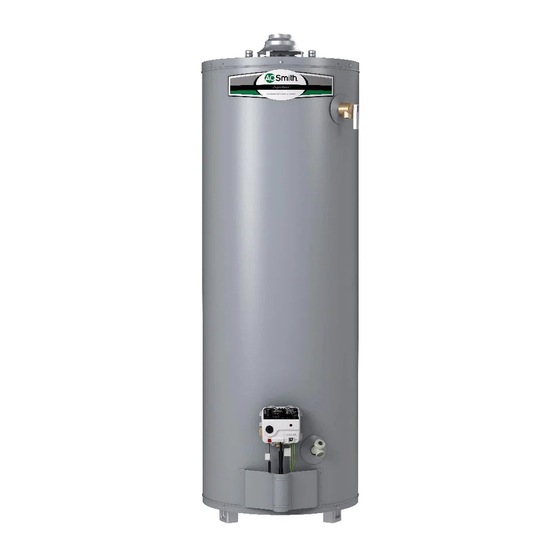
Table of Contents
Advertisement
ALL TECHNICAL AND WARRANTY QUESTIONS: SHOULD BE DIRECTED TO THE LOCAL DEALER FROM WHOM THE WATER HEATER WAS
PURCHASED. IF YOU ARE UNSUCCESSFUL, PLEASE WRITE TO THE COMPANY LISTED ON THE RATING PLATE ON THE WATER HEATER.
KEEP THIS MANUAL IN THE POCKET ON HEATER FOR FUTURE REFERENCE
PRINTED IN THE U.S.A 0905
RESIDENTIAL GAS W
RESIDENTIAL GAS W A A A A A TER HEA
RESIDENTIAL GAS W
RESIDENTIAL GAS W
RESIDENTIAL GAS W
GAMA certification applies to
all residential gas water
heaters with capacities of 20
to 100 gallons with input rating
of 75,000 BTU/Hr. or less.
WHENEVER MAINTENANCE ADJUSTMENT OR SERVICE IS REQUIRED.
Instruction Manual
NOT FOR USE IN MANUFACTURED (MOBILE) HOMES
C3 Technology
®
Gas Water Heaters meet the new
ANSI Z21.10.1 standard that deals with the accidental or
unintended ignition of flammable vapors, such as those
emitted by gasoline.
•
For Your Safety
AN ODORANT IS ADDED TO THE GAS USED
BY THIS WATER HEATER.
1
TER HEA
TER HEA TERS
TER HEA
TERS
TERS
TERS
TER HEA
TERS
®
•
PART NO. 184165-003
Advertisement
Table of Contents

Summarization of Contents
SAFE INSTALLATION, USE AND SERVICE
IMPORTANT DEFINITIONS
Provides definitions for key terms like Qualified Installer, Service Agency, and Gas Supplier.
GENERAL SAFETY
Fire Hazard
Details risks of fire and precautions to prevent it, including floor installation and flood damage.
Scald Hazard
Warns about severe burns from hot water and identifies high-risk groups.
Explosion Hazard
Addresses risks of water tank explosion due to overheating and relief valve requirements.
Fire or Explosion Hazard
Details hazards from flammable vapors, gas pressure, and ignition sources.
Breathing Hazard - Carbon Monoxide Gas
Highlights risks of carbon monoxide poisoning and necessary installation/venting precautions.
Improper installation and use
Warns about property damage from incorrect installation, drainage, and operation.
INTRODUCTION
Preparing for the New Installation
Outlines essential steps and considerations before beginning water heater installation.
TYPICAL INSTALLATION
GET TO KNOW YOUR WATER HEATER - GAS MODELS
Identifies and illustrates key components of the gas water heater for installation.
MIXING VALVE USAGE
Explains the use and importance of mixing valves for preventing scalds with hot water.
LOCATING THE NEW WATER HEATER
FACTS TO CONSIDER ABOUT THE LOCATION
Details factors for choosing a safe and economical location, avoiding specific hazards.
COMBUSTION AIR AND VENTILATION FOR APPLIANCES LOCATED IN UNCONFINED SPACES
Specifies air requirements for water heaters installed in spaces with adequate air volume.
INSULATION BLANKETS
Addresses the use of external insulation blankets and their potential impact on operation.
COMBUSTION AIR AND VENTILATION FOR APPLIANCES LOCATED IN CONFINED SPACES
Outlines air supply requirements for water heaters installed in spaces with limited air volume.
INSTALLING THE NEW WATER HEATER
WATER PIPING
Details the procedures and precautions for connecting water supply and outlet lines.
TEMPERATURE-PRESSURE RELIEF VALVE
Explains the function, installation, and safety requirements of the T&P relief valve.
FILLING THE WATER HEATER
Step-by-step guide on how to properly fill the water heater tank before operation.
VENTING
Covers essential guidelines for connecting the water heater to a proper venting system.
GAS PIPING
Instructions and warnings for connecting the gas supply line, including pressure and type.
SEDIMENT TRAPS
Explains the purpose and installation of sediment traps in the gas supply line.
FOR YOUR SAFETY READ BEFORE LIGHTING
BEFORE OPERATING
Mandatory checks, including filling the tank and purging air, before initial operation.
WHAT TO DO IF YOU SMELL GAS
Emergency procedures to follow immediately if a gas leak is detected.
LIGHTING INSTRUCTIONS
Detailed steps for safely igniting the pilot light and main burner.
TO TURN OFF GAS TO APPLIANCE
Procedure for safely shutting off the gas supply to the water heater.
TEMPERATURE REGULATION
START UP CONDITIONS
Information on what to expect during the initial operation and startup phase.
DRAFT HOOD OPERATION
Instructions on checking the draft hood for proper function and ventilation.
CONDENSATE
Explanation of condensate formation, its causes, and potential issues.
OPERATIONAL CONDITIONS
SMELLY WATER
Explains causes of smelly water, often related to the anode rod and water chemistry.
THERMAL EXPANSION
Addresses the phenomenon of thermal expansion and required corrective measures.
STRANGE SOUNDS
Describes normal operational noises and potential causes of unusual sounds.
PERIODIC MAINTENANCE
VENTING SYSTEM INSPECTION
Guidelines for inspecting the vent system for obstructions, damage, and proper function.
BURNER INSPECTION
Recommendations for visually inspecting the main and pilot burners annually.
BURNER CLEANING
Instructions and recommendations for cleaning the water heater's burner assembly.
HOUSEKEEPING
Advice on maintaining a clean environment around the water heater.
ANODE ROD INSPECTION
Details the importance of anode rod inspection for tank corrosion protection.
TEMPERATURE-PRESSURE RELIEF VALVE OPERATION
Instructions on how to manually test the temperature-pressure relief valve.
DRAINING
Procedures for draining the water heater tank for maintenance or storage.
DRAIN VALVE WASHER REPLACEMENT
Steps for replacing the washer in the water heater's drain valve.
SERVICE
LEAKAGE CHECKPOINTS
A guide to identifying common sources of water leaks in the water heater system.










Need help?
Do you have a question about the FCG-75 and is the answer not in the manual?
Questions and answers